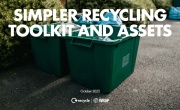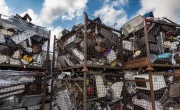Why some key European recycling markets are ‘dysfunctional’
Most European markets for secondary raw materials (SRM) are ‘dysfunctional’, according to a report just published by the European Environment Agency, the body tasked with evaluating environmental policy and performance for the European Union.

Investigating Europe′s Secondary Raw Material Markets sets out a framework for assessing how well an SRM is working, applying it to eight key material streams that have a well-established recycling infrastructure. This, the report states, is an essential aspect of delivering on the potential of the circular economy and ‘minimising the need to extract natural resources as a result’.
Effective secondary raw materials markets
The framework identifies the following key pillars to ensure that a market for recyclate is working effectively:
- recyclable material has a significant share of the who market for the material (including primary/raw materials)
- prices of the SRM reflect the behaviour of demand and supply for the material in question
- there is an international or wide scope affecting the transactions, such that there are excessive local distortions
- ‘adequate economic drivers’ for the material, such that the market is supported even with the influence of government legislation or policies
- a robust reprocessing infrastructure for the material
- a good availability of market information, so actors are able to participate on an even playing field
- Well-understood or measurable product standardisation or grading
These are specified as 12 criteria used for assessing each secondary materials market
Market size and growth criteria:
1. Relevance of SRM as a share of total market size for the material
2. Stable/increasing supply and demand leading to steady pricing
3. Open international trade and high material value to transport cost ratio for stability and liquidity of market
4. Large industrial capacity creating demand for SRM as an input
Role of policy drivers in market development criteria:
5. Independent survival of market without policy support
6. Involvement in closed-loop circular schemes for increased demand and supply stability
7. No competition from energy recovery operations affecting SRM market demand.
Prices criteria:
8. Availability of reference international/national prices for transactions and contracts
9. Presence of organised markets for trading through platforms and contracts
10. Open and continuous flow of supply/demand information and prices to all market actors
Technical specifications and barriers criteria:
11. Standardised product specifications for SRM as references in transactions and contracts
12. Absence of regulatory barriers for SRM use as industrial commodity, including in end-of-waste process.
Secondary markets performance
In applying these criteria to the SRMs that are the focus of the report, the EEA notes that only the markets for aluminium, paper and glass appear to be functioning adequately. The others that were assessed, plastics, wood, textiles, biowaste, and aggregates from construction and demolition waste were all identified to have failings.
The efforts to boost recycling through policies has led to a steady supply of recyclates, but the supply side of SRM markets still faces challenges. The main issues are insufficient end-of-waste criteria and contamination with hazardous substances. The demand side is hindered by a lack of trust in SRMs, hindering confidence for investors in technology to integrate SRMs into raw material supply operations.
The report notes that: “A cross-cutting issue impacting market functionality is the lack of adequate information for interested stakeholders, and the absence of a monitoring mechanism to observe the market and propose improvements.”
Commenting on the report Stéphane Arditi, Director for Climate, Circular Economy and Industry for the European Environmental Bureau (EEB): “The EEA report is welcome and of great relevance, notably as it tries to analyse the status of markets for secondary raw materials, based on a set of criteria that can be qualified if not quantified.
“This does not only help to assess the situation but also to point to improvement directions that can be applied across a range of materials or to individual material streams. The report is also adopting a life cycle perspective, enabling us to spot challenges and opportunities at each step of the value chain, notably the post consumption reverse value chain.”
He added: “It is striking that markets are not well functioning when various policy instruments and information schemes have not been set. There is indeed a perfect match between [material] streams not working well and the poor scoring on these two criteria (when the match between the findings and other instruments are slightly less systematic. Without pretending that these two criteria are sufficient, it is clear that they appear as necessary conditions. Most of the recommendations are also pointing in the direction of these two criteria.
Plastics
With plastic recycling rates for plastic packaging varying considerably across Europe – with the average being 42 per cent in 2018 – the report breaks its analysis into different sources of plastic waste.
Plastic waste ′collected for recycling′ also does not always correspond to the amount that is actually recycled. The EEA notes that the challenges of producing high-quality secondary plastics have been brought up in recent reports.
The report notes that the functioning of the secondary plastics market ‘varies from polymer to polymer’. The market for rPET is somewhat well-functioning. However, for most other polymers and especially for mixed plastics/composites, the market cannot yet be considered well-functioning. It concludes that overall the market for secondary plastics is not well-functioning.
Arditi highlights the lack of available information, and therefore lack of trust, with regards to contamination from hazardous chemicals. He added that the problem extends beyond plastics although it is ‘certainly most detrimental’ in this specific stream.
He continued: “The report still focuses on packaging plastics, the main sector for plastic waste production, but [the EEB] thinks it’s time to also consider other plastic streams.
“They may represent a proportionally higher rate of plastic waste in the future as we try to get rid of single-use plastic packaging and applications.
“Non-packaging plastics are placed on the market with various chemical contents due to their technical specifications, and those chemicals may turn hazardous over time, even if not considered so at the time of initial placement on the market.
Aluminium
One of only three markets deemed to be functioning well, the report found the aluminium recycling rates to be among the highest rates analysed: in Europe, recycling rates are over 90 per cent in the automotive and building sectors, and 75 per cent for aluminium cans.
A report by SITRA/Material Economics, quoted within the EEA report, points to the need to improve the quality of secondary steel and aluminium to further unleash their potential to substitute for primary materials.
Arditi said that a follow-up for the EEA was the potential for the findings for the aluminium stream to be extrapolated for other metal waste streams, such as steel and copper. He notes that, while the report does not explicitly make the comparison, the frequent association between aluminium and ferrous metals and copper could indicate so.
He added: “The case for metallic Critical Raw Materials is also quickly touched upon and may deserve to be assessed versus the 12 criteria.
“A proper functioning market for these critical metals will become more and more strategic in view of their essential role in a climate-friendly transition, as well as their role in the continuous digitalisation of our economy.”
Wood
While the report finds the market for solid recovered fuel has ‘the potential to be well-functioning’, it does not fully meet the criteria in terms of quantities and industrial capacity. It is the poorest scoring of the analysed markets, only meeting nine out of 12 criteria.
Arditi adds that this hints at a competition with energy use: “We think that when it comes to wood and bio-based products, the renewability perspective may often lead [the neglect] of circularity potentials.
“...the circularity perspective should not be lost because the material stream is renewable and bio-based. It is fundamental that we also apply [circularity and waste treatment hierarchy principles] to biomass and do not simply shift on a one-to-one basis from non-renewable resources to renewables as this endangers our biodiversity goals.
Glass
According to the report, the market for cullet, the secondary material derived from glass waste, has the potential to be a well-functioning or mature market. It meets most of the relevant criteria, but there are some limitations in terms of the strong role of waste policies in its market development and low tradability and lack of organised markets.
The two critical factors for the functionality of a secondary material market are market size and material quality, and glass scores well in both. Most of the recovered glass is used for producing new glass packaging and there are systems in place for quality management of the recycling feedstock and for the end-of-waste criteria for cullet.
Biowaste and construction and demolition waste SRM markets
EU legislation requires municipal biowaste to be separately collected by the end of 2023, but the report still finds that the market still needs to be developed to be considered well-functioning.
The same is true for construction and demolition waste, which the EEA found to have under-used recycling potential despite an existing market for aggregates derived from waste in roads, drainage and other construction projects.
Arditi commented: “Due to weight and most of the time low value of construction and demolition waste or biowaste, the emergence of local markets is essential. The question of trust, certification and bridging between local stakeholders is rightly highlighted according to us, and for these two markets, the role of policy and information schemes are identified as key leverages.”
Textiles
The report highlights a lack of policy and information surrounding textiles. It points to issues surrounding quantities, such as the share of SRM with respect to total market size, the industrial capacity for producing SRM, the stability of supply and demand, and the presence of compliance schemes, such as EPR schemes.
It was the second lowest scoring market, after wood, but the policy officer notes it does not suffer the same severe competition from energy use as wood does.
“It is not exaggerated to say that the secondary market for textiles is totally underdeveloped and needs a clear boost,” Arditi says.
“The problem with textiles SRM is essentially a question of over-consumption of low quality and cheap new garments, resulting in a massive waste generation which is not cost-effective to recycle and so far has not been addressed by any sound policy. The implementation of the EU textiles strategy could be a game changer.”
Recommendations and policy options
According to the EEA report, the market for secondary raw materials (SRMs) has the potential to contribute significantly to the advancement of resource sustainability and efficiency.However, in order for these markets to operate efficiently, there are a number of obstacles that need to be removed.
There is still potential for improvement despite the fact that current policy instruments like extended producer responsibility programmes, green public procurement, and recycling targets have assisted in the advancement of SRM markets.
The development of end-of-waste criteria, raising recycled content requirements, and expanding the use of these policy tools are just a few of the approaches that can help to improve the efficiency of SRM markets. SRM markets have the ability to significantly advance the circular economy and lessen the negative environmental effects of garbage by removing these obstacles.
In addition to modifying existing policy tools, entirely new policy measures could also play a crucial role in improving the functionality of SRM markets.
For instance, developing harmonised, EU-wide technical standards for SRMs could provide a much-needed boost to the industry.
Another measure could be creating a fair and equal environment for primary and secondary raw materials by considering their environmental impact through taxation of primary raw materials or reduction in the value-added tax for SRMs. These measures could bring a new level of standardisation and fairness to the market, making it easier for SRMs to compete with traditional primary materials.
Reflecting on the overall report Arditi stated it was ‘good in its recommendations and identification of policy options’.
He added: “Even if each route could be impact assessed with more scrutiny (and this is not the object of the report), the recommendations are credible as most of them are based on proven record of effectiveness.”
“The taxation on virgin raw materials and reduced VAT on SRM are probably the most innovative and may deserve being investigated with pros and cons as stated in the report, but they seem to make sense and have in fact be partially used in modelling exercises on Circular Economy at OECD level.”
However, he felt that the report did not refer more explicitly to three additional directions to create a sound environment for all SRM markets, even beyond the specific streams targeted in this report:
- First the setting of a EU wide resource use reduction target – a material footprint reduction target in more technical terms. Such a target, as exists for GHG emissions reduction, and already in place in certain Member States would result in paying more attention to the resources we use, primarily virgin resources and could enhance a more systematic uptake of secondary materials to mitigate EU material footprint
- Second, the setting of a complementary ambitious legal objective on the circular material use rate, as already captured in the monitoring framework of the Circular Economy, at EU level. Today, this rate is at 11.8% and is not evolving in the right direction.
- Third, the more systematic disclosure of carbon and environmental footprint and chemical contents of products placed on the market with associated thresholds to be made more stringent over time. In fact, such information would be beneficial for secondary raw material who most often performed better than virgin counterparts on climate and environment but cannot be valued enough today due to poor recognition and visibility or are suffering mistrust as potentially containing hazardous substances.






